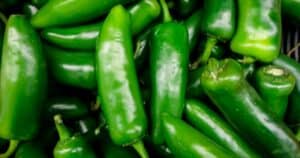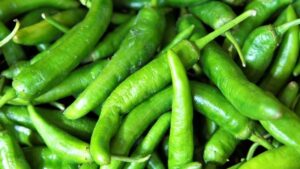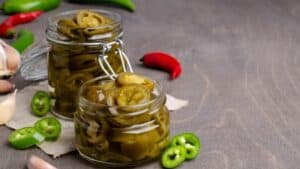When planting a garden, especially one full of fruits and vegetables, it’s important to know where each plant will grow best. Certain plants are better grown together, while others should be grown separately. If you’re growing a personal collection of hot peppers, you may wonder if you can plant habaneros and jalapeños together.
You certainly can plant habaneros and jalapeños together! jalapeños and habaneros require similar growing conditions, so it makes sense to plant them near each other. The only caveat is that you risk cross-pollination if you want to use the seeds next year.
If
Planting Habaneros and Jalapeños
Habanero and jalapeño plants share many of the same needs with each other and other pepper plants. Both plants grow best in warmer climates and strong sunlight. Their soil should be slightly acidic, and gardeners will want to avoid overwatering the plants.
If you’re growing peppers from seeds, you should start them inside and transfer them outdoors once the weather is warm enough.
Plant them 18 inches (46 centimeters) apart in an area with plenty of sun. Peppers do best in mulch, and planting them in mulch will reduce weeds. When it’s time to harvest them, make sure you wear gloves so that the capsaicin doesn’t irritate your skin or eyes.
The Best Conditions for Habanero Peppers

As mentioned above, you should start your pepper seeds inside. Habanero peppers will need to grow for about 8-10 weeks before they’re ready to transplant. If you live in a more arid and tropical climate, you can plant the peppers outside two weeks before the expected last frost.
In addition to being 18 inches apart, plant your habanero seeds about ½ inch deep in an area that gets bright sun.
Habaneros can become bitter if they’re overwatered but also can’t be left to dry out. They do best with infrequent but deep watering. Row covers can help avoid drying and cracking.
You can harvest your habaneros when they’re green or red. Regardless, you should then harvest the peppers before temperatures drop in the fall.
The Best Conditions for Jalapeño Peppers

Like habanero peppers, peppers grow best when you start them inside 8-10 weeks before the last frost. Your soil should be at least 70°F (21°C), and nighttime temperatures should be above 60°F (15°C) to keep your jalapeños from getting too cold.
Find a place in your garden that gets plenty of sunlight and plant your seedlings 14-24 inches apart. Water deeply when you plant, but be careful not to overwater afterward. Wait until the top one or two inches of soil have dried before watering again.
As your jalapeño peppers grow, you will likely need to support them with a stick or cage. You’ll know your jalapeños are ready to harvest when they’re red. Cut the peppers from the plant rather than pull them off, as pulling can damage the plant.
Risk of Cross-Pollination
Whenever you plant two genetically similar plants together, you risk cross-pollination. Cross-pollination occurs when a plant is pollinated with the pollen of a plant of a different species.
If you plant habaneros and jalapeños together, you risk cross-pollination. However, cross-pollination will not affect the peppers you are currently growing. Instead, it affects the seeds. If you plan to use the seeds of your habaneros and jalapeños to grow more plants next year, you’ll want to separate them.
Another option is to let them cross-pollinate and see what kind of peppers you get from the crossed seeds. You might get a pepper hybrid that is even better than the others!
Planting Jalapeño-Habanero Hybrids
If you don’t mind some interesting results, you can intentionally cross-pollinate your jalapeño and habanero peppers. When you cross-pollinate two pepper varieties, you get a hybrid pepper with traits from both parents.
Jalapeño and habanero hybrids will likely be hotter than jalapeños but milder than habaneros. They may have the elongated shape of a jalapeño or the wrinkled appearance of a habanero. The peppers could end up any shade of green, red, orange, or yellow depending on the parent varieties.
Hybrid peppers are always a fun experiment for gardeners who don’t mind surprises. Just remember, if you plan to save seeds from a hybrid pepper, its offspring likely won’t share the exact same traits. The only way to keep consistent hybrids is to continue manually cross-pollinating the parent varieties each season.
Other Plants To Grow With Peppers
Some fruits and vegetables grow better alongside peppers than others. The best plants to grow with peppers each have their own benefit. These include:
- Basil. As an herb, basil wards off pests like thrips, aphids, flies, and mosquitos. It may also help enhance the flavor of your peppers.
- Parsley. Another cooking favorite, parsley attracts wasps that feed on otherwise harmful aphids.
- Chives. Like basil, chives deter pests while enhancing the flavor of your peppers.
- Onions. Planting onions with your peppers will help keep out unwanted pests like cabbage worms, slugs, and aphids.
- Okra. Okra deters pests while also offering wind protection and shade.
- Carrots, chard, and spinach. All three help crowd out weeds and space out your peppers. Chard can also protect your peppers from wind and too much sun.
The above is by no means an exhaustive list, as many other plants will do just fine next to peppers.
There are also a few plants you should avoid planting with peppers:
- Fennel. In general, you shouldn’t plant fennel with any other fruits or vegetables. It’s tasty, but it attracts bugs.
- Any plants in the Brassicaceae family. These plants include any of your cabbage or mustard plants, including kale, cauliflower, broccoli, brussels sprouts, and turnips. You should avoid planting them with your peppers because they need a more neutral soil than the slightly acidic soil preferred by peppers.
Planting Peppers With Other Nightshades
All peppers are part of the Solanaceae family, colloquially known as nightshades. This family also includes plants like tomatoes, potatoes, and eggplants. So if you can plant different species of peppers together, can you plant peppers with other nightshades?
The answer is: yes, but with a caveat.
Peppers actually grow really well alongside other members of the nightshade family. The problem is that diseases that affect one member of the nightshade family can spread to the rest. If all your nightshades are near each other, those diseases will hop from tomatoes to potatoes to peppers and around again.
However, if you’re careful, you won’t need to worry. If you work to prevent diseases and rotate your crops, you can protect your peppers from disease.
Preventing Pepper Diseases
There are a few ways you can actively fight diseases in your garden:
- Look into what diseases may affect your plants and which are common in your area.
- Check to see if you can find strains of peppers that are immune to common diseases.
- Inspect seeds and plants for any signs of disease before planting them in your garden.
- Keep your tools clean so as not to spread bacteria.
- Avoid too much moisture, as this allows fungi and bacteria to thrive.
- Stay on top of weeding so your plants stay healthy.
- Frequently inspect your plants and remove them at the first signs of disease.
Rotating Your Pepper Crops
Rotating crops is the best way to prevent weeds, insects, and diseases from returning year after year. Ideally, plant your peppers in an area where you haven’t planted any nightshade in 2-4 years. By constantly rotating your crops, you ensure that any nightshade diseases that lived through the winter in the soil won’t harm them another year. It also helps prevent the soil from being depleted of any essential nutrients.
Conclusion
Can you plant two different peppers together, like habanero peppers and jalapeño peppers? Absolutely you can! Peppers share similar sun, water, and soil needs, so they have no problems growing together.
Be careful of cross-pollination, nightshade diseases, and what plants you should and shouldn’t plant with peppers. So long as you grow your peppers where they’ll thrive and remember to rotate your crops every year, you’ll end up with a gorgeous crop.
Sources
- University of Minnesota Extension: Growing Peppers in Home Gardens
- Gardening Know-How: Habanero Plant – How To Grow Habanero Pepper
- Almanac: First and Last Frost Dates
- Almanac: Jalapeño Peppers
- Sandia Seed Company: Companion Plants for Chile Peppers
- Gardenine: 10 Best Companion Plants for Peppers [+ What NOT to Plant with Peppers]
- Pepper Geek: Best (and Worst) Pepper Plant Companions in the Garden
- Pure Wow: Wondering What Not to Plant with Peppers? Here’s What to Avoid—and What’s Worth Trying
- University of Minnesota Extension: Growing Healthy Vegetables
- University of Minnesota Extension: Plant Diseases





